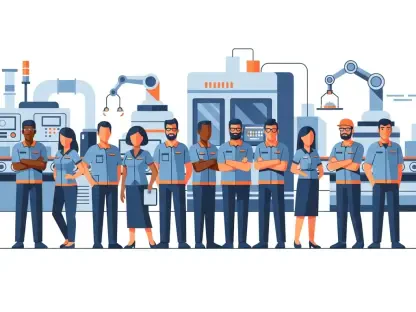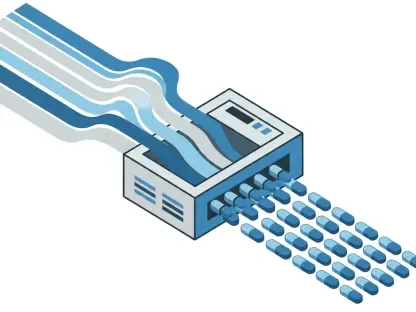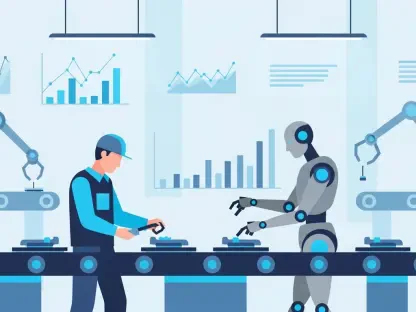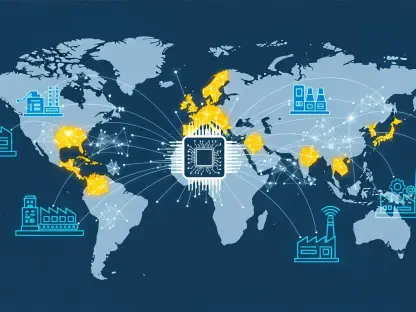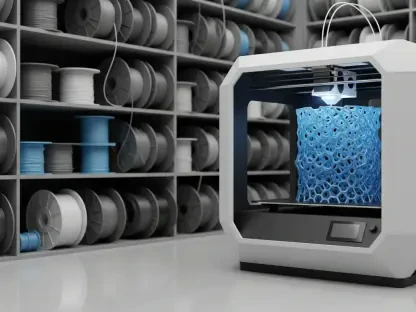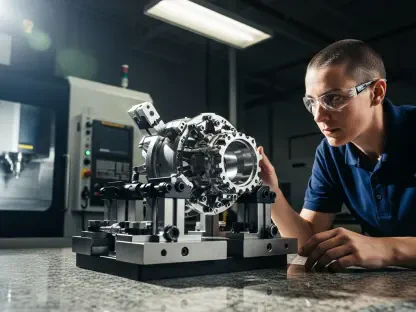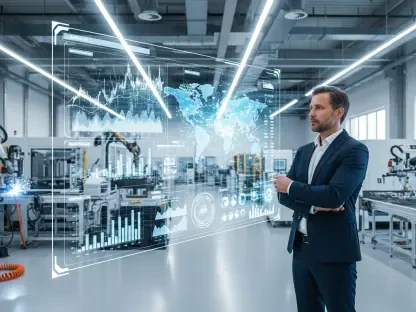Imagine a factory where machines predict their own breakdowns before they happen, where supply chains adjust in real time to meet demand, and where quality control is so precise that defects are nearly extinct. This is no longer a distant vision but a tangible reality in many manufacturing hubs across the globe, driven by the relentless rise of artificial intelligence (AI). Often described as the backbone of Industry 4.0, AI is redefining how goods are produced, turning traditional factory floors into smart, data-driven ecosystems. Far from just automating repetitive tasks, this technology empowers manufacturers to achieve unprecedented levels of efficiency, safety, and adaptability. As industries race to stay competitive, understanding the depth of AI’s influence becomes essential. This exploration delves into the historical roots of AI in manufacturing, its current applications, the cutting-edge innovations propelling it forward, and the challenges and strategies shaping its future. By examining these facets, a clearer picture emerges of how AI is not just a tool but a transformative force that is fundamentally altering the manufacturing landscape for the better.
The Roots of AI in Modern Manufacturing
The story of AI in manufacturing begins decades ago, with humble origins in the 1980s when computer-aided design (CAD) and rudimentary robotics first entered industrial settings. These early tools marked the initial steps toward automation, focusing on streamlining basic tasks and reducing human error in design and production. While limited in scope, they set a critical foundation by introducing data as a key component of decision-making. Over time, methodologies like lean manufacturing gained traction, emphasizing efficiency through systematic analysis. This era demonstrated that technology could do more than assist—it could optimize. Fast forward to the 2000s, and the landscape shifted dramatically with the arrival of the Industrial Internet of Things (IIoT) and cloud computing. These advancements allowed factories to gather and process vast amounts of data in real time, creating opportunities for more sophisticated systems. The transition from isolated automation to interconnected, intelligent networks laid the groundwork for what is seen today as a new industrial revolution, where AI plays a central role in driving smarter production environments.
Today’s AI systems in manufacturing bear little resemblance to their early predecessors, showcasing a remarkable evolution in capability and integration. Unlike the standalone robots of the past that simply replaced manual labor, modern AI works in tandem with human operators, enhancing rather than replacing their roles. It analyzes complex datasets to fine-tune assembly lines, predict maintenance needs, and even adapt to unexpected changes on the factory floor. This shift is emblematic of Industry 4.0, a paradigm where connectivity and intelligence converge to create adaptive manufacturing spaces. The historical trajectory underscores a critical point: AI’s growth in this sector has been less about sudden leaps and more about steady, cumulative progress. Each technological milestone, from early machine learning algorithms to current cloud-based analytics, has built upon the last, resulting in systems that are not only automated but also insightful, paving the way for a future where human-machine collaboration reaches new heights.
Unlocking Efficiency: Core Benefits of AI
One of the most compelling aspects of AI in manufacturing lies in its ability to drastically enhance operational efficiency through targeted applications. Predictive maintenance stands as a prime example, where AI algorithms sift through machine performance data to forecast potential failures long before they occur. This foresight minimizes unplanned downtime, which can cost industries millions annually, and extends the lifespan of critical equipment. Beyond saving costs, it allows for smoother production schedules, as maintenance can be planned during off-peak times. This capability transforms how manufacturers approach asset management, shifting from reactive repairs to proactive strategies. The ripple effect is felt across the entire operation, as consistent uptime directly translates to higher output and better resource allocation, proving AI’s value in tangible, bottom-line results.
Beyond maintenance, AI’s impact on quality control and supply chain management offers equally transformative benefits. In quality assurance, AI-driven computer vision systems inspect products at speeds and precision levels unattainable by human workers, identifying even the smallest defects with uncanny accuracy. This ensures that only top-tier products reach the market, bolstering brand reputation and reducing waste. Meanwhile, in supply chains, AI enhances forecasting by analyzing market trends and historical data, enabling manufacturers to maintain optimal inventory levels without overstocking or shortages. Worker safety also sees improvement, as AI monitors factory conditions and powers collaborative robots that reduce physical strain and accident risks. These diverse advantages illustrate that AI is not a singular solution but a multifaceted tool, addressing critical pain points across manufacturing processes while fostering environments that prioritize both productivity and human well-being.
Innovation at Work: AI Technologies Leading the Charge
The rapid evolution of AI technologies is a driving force behind manufacturing’s transformation, with several breakthroughs reshaping what’s possible on the factory floor. Generative AI, initially developed for creative outputs like text and images, has found a powerful niche in industrial design by generating optimized component structures and production workflows. This technology cuts down on trial-and-error phases, allowing engineers to focus on refinement rather than starting from scratch. Similarly, digital twins—virtual replicas of physical systems—have advanced from simple models to complex simulations that integrate real-time data from IIoT sensors. Manufacturers can now test operational changes or troubleshoot issues in a risk-free digital space, saving time and resources. These tools exemplify how AI is pushing boundaries, turning abstract concepts into practical, game-changing applications that redefine efficiency.
Another frontier of innovation lies in edge AI and the nascent field of agentic AI, both of which signal a shift toward greater autonomy in manufacturing systems. Edge AI processes data directly on factory equipment, bypassing the need for cloud connectivity and enabling split-second decisions in tasks like quality inspections or robotic adjustments. This localized processing boosts speed and reduces latency, critical for high-stakes environments. Meanwhile, agentic AI, though still experimental, hints at a future where systems exhibit basic reasoning and adaptability, potentially automating intricate decision-making processes without constant human input. These advancements are not just incremental upgrades but indicators of a broader trend toward smarter, self-sufficient factories. As these technologies mature, they promise to further blur the line between human oversight and machine independence, setting a new standard for precision and responsiveness in industrial operations.
Adoption Realities: Where AI Stands in Manufacturing
Despite the undeniable potential of AI, its integration into manufacturing remains a patchwork of progress and hesitation across the industry. Larger corporations with ample budgets often lead the way, embedding AI seamlessly into their supply chains and production lines to gain a competitive edge. These early adopters showcase impressive results, from reduced operational costs to enhanced product consistency, setting benchmarks for others to follow. However, the reality for many smaller manufacturers is starkly different, as they grapple with financial constraints and a lack of technical expertise to implement such systems. This disparity creates a fragmented landscape where innovation thrives in some corners while others lag, struggling to justify the investment against uncertain short-term gains. The uneven adoption rate highlights a critical divide that must be addressed for AI to achieve widespread impact.
Further complicating the picture is the so-called “productivity paradox,” a phenomenon where significant investments in AI don’t always yield immediate efficiency improvements. Many companies find themselves stuck in experimental phases, running pilot projects that show promise but fail to scale across entire operations due to integration challenges or mismatched expectations. Surveys indicate that while interest and funding for AI in manufacturing are on the rise, full-scale deployment often remains elusive, particularly for mid-sized firms lacking the infrastructure of their larger counterparts. This gap between ambition and execution underscores a broader truth: adopting AI is not merely a matter of purchasing technology but requires a holistic overhaul of processes, culture, and strategy. Until these systemic barriers are overcome, the transformative power of AI will remain tantalizingly out of reach for a significant portion of the industry.
Hurdles to Overcome: Challenges in AI Implementation
Integrating AI into manufacturing is far from straightforward, with several formidable challenges standing in the way of seamless adoption. High initial costs represent a primary barrier, as acquiring cutting-edge technology and hiring skilled personnel to manage it can strain budgets, especially for smaller enterprises. Beyond the financial burden, the complexity of implementation adds another layer of difficulty, as AI systems often require extensive customization to align with specific factory needs. This process can be daunting for organizations without in-house expertise, leading to delays and inefficiencies. Moreover, the return on investment is not always immediate, creating hesitation among decision-makers who must balance short-term fiscal pressures with long-term strategic goals. These economic and logistical hurdles collectively slow the pace at which AI can revolutionize the sector.
Technical and organizational obstacles further compound the challenge of AI integration, painting a picture of an industry at a crossroads. Data quality issues frequently arise, as many factories operate with fragmented or incomplete datasets that undermine AI’s effectiveness. Legacy equipment, often incompatible with modern solutions, poses another roadblock, requiring costly upgrades or replacements. Workforce readiness is equally critical, as employees need training to interact with AI tools effectively, a process that demands time and resources. Additionally, the rise of connected devices heightens cybersecurity risks, with potential breaches threatening sensitive operational data and necessitating robust, expensive safeguards. These multifaceted challenges indicate that while AI holds immense promise, its successful deployment hinges on overcoming a web of interconnected financial, technical, and human factors through deliberate planning and investment.
Charting the Path: Strategies for Sustainable AI Success
To harness AI’s potential over the long haul, manufacturers must adopt strategic approaches that prioritize sustainability over fleeting experimentation. Building a robust data infrastructure emerges as a foundational step, since AI’s effectiveness depends heavily on access to high-quality, well-organized information. This means investing in systems that can collect, store, and process data seamlessly across operations, eliminating silos that hinder performance. Equally important is a focus on scalability from the outset—pilot projects should be designed with the intent to expand successful initiatives across multiple facilities, avoiding the trap of isolated successes. By laying this groundwork, companies can create an environment where AI doesn’t just solve immediate problems but evolves as a core component of their operational framework, delivering consistent value over time.
Another critical strategy involves human capital and partnerships, ensuring that the workforce and external collaborators are aligned with AI goals. Early and comprehensive training programs for employees are essential, going beyond basic technical skills to foster a culture of collaboration with intelligent systems. This prepares staff to adapt to evolving roles where AI augments rather than replaces their contributions. Additionally, forming alliances with technology providers can alleviate financial and expertise gaps, offering access to cutting-edge tools and support without the burden of developing solutions in-house. Perhaps most crucially, AI adoption should be driven by specific business challenges—whether reducing downtime or improving product quality—ensuring measurable outcomes rather than chasing innovation for its own sake. These deliberate, problem-focused strategies can transform AI from a risky gamble into a reliable engine of progress in manufacturing.
Emerging Patterns: Broader Trends in AI’s Role
Looking at the bigger picture, several defining trends highlight AI’s growing influence within the manufacturing sphere under the umbrella of Industry 4.0. The move toward smart factories is undeniable, where interconnected systems powered by AI enable real-time decision-making and adaptability on an unprecedented scale. This shift reimagines production as a dynamic, data-driven process rather than a static assembly line, with AI acting as the central nervous system. Such transformation is not merely technological but philosophical, reflecting a broader industry consensus that intelligence and connectivity are no longer optional but essential for staying competitive. As this paradigm takes hold, it becomes clear that AI is reshaping the very definition of what a factory can be, pushing toward a future of seamless efficiency.
Yet, alongside this momentum, disparities in adoption reveal another critical trend that shapes the landscape. While the benefits of AI—from cost savings to enhanced safety—are widely recognized, the ability to implement it varies significantly based on company size and resources. Larger entities often set the pace, leveraging AI to redefine benchmarks, while smaller players struggle to keep up, constrained by budget and infrastructure limitations. Meanwhile, technological advancements like edge AI and digital twins continue to expand the realm of possibility, hinting at a future where autonomy and precision dominate. The overarching viewpoint within the industry suggests that AI is no longer a speculative concept but a fundamental pillar of modern manufacturing. However, its ultimate success depends on tailored approaches that address the unique needs and readiness of each organization, ensuring that progress is inclusive rather than exclusive.
Moving Forward: Reflections on AI’s Manufacturing Legacy
Reflecting on the journey so far, it’s evident that AI has carved a significant path in manufacturing by revolutionizing workflows, elevating quality standards, and prioritizing safety across factory floors. Its evolution from rudimentary automation to sophisticated, intelligent systems showcases a remarkable capacity to adapt and innovate over time. Challenges such as steep costs, inconsistent data, and cybersecurity vulnerabilities have tempered the pace of adoption, often creating a divide between industry leaders and laggards. Yet, through strategic efforts focused on robust data systems, workforce training, and targeted problem-solving, many manufacturers have overcome these barriers to unlock substantial gains. Looking ahead, the emphasis should shift to bridging adoption gaps by making AI solutions more accessible to smaller firms through shared resources or government-backed initiatives. Prioritizing cybersecurity measures will also be vital as connectivity grows. By focusing on these actionable steps, the industry can ensure that AI’s transformative impact continues to expand, setting a new benchmark for what manufacturing can achieve in a technology-driven era.


